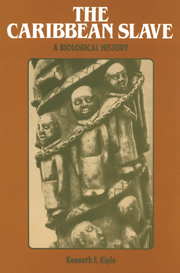Book contents
- Frontmatter
- Contents
- List of Tables
- Preface
- Acknowledgments
- Part I Background and Biology
- Part II Diet, Disease, and Demography
- Introduction
- 4 The Middle Passage and Malnutrition
- 5 Plantation Nutrition
- 6 Malnutrition: Morbidity and Mortality
- 7 Slave Demography
- 8 Slave Infant and Child Mortality
- 9 Black Diseases and White Medicine
- Part III Pathogens and Politics
- Notes
- Bibliographic Essay
- Index
8 - Slave Infant and Child Mortality
Published online by Cambridge University Press: 19 October 2009
- Frontmatter
- Contents
- List of Tables
- Preface
- Acknowledgments
- Part I Background and Biology
- Part II Diet, Disease, and Demography
- Introduction
- 4 The Middle Passage and Malnutrition
- 5 Plantation Nutrition
- 6 Malnutrition: Morbidity and Mortality
- 7 Slave Demography
- 8 Slave Infant and Child Mortality
- 9 Black Diseases and White Medicine
- Part III Pathogens and Politics
- Notes
- Bibliographic Essay
- Index
Summary
While the infant mortality in a poor community may be 10 times higher than in a prosperous one, the mortality in the 1 to 4 year age group may be 50 times higher.
Sir Stanley Davidson et al (1975)The instances of [Jamaican slave mothers] who have had four, five, six children, without succeeding in bringing up one, in spite of the utmost attention and indulgence are very numerous.
M.G. Lewis (1816)As I have already suggested, the failure of the slave populations of the West Indies to increase by natural means was not the result of low fertility, but rather the consequence of a blending of genetic, cultural, immunological, and especially nutritional factors, which quickly converted so many birth statistics into death statistics that natural population growth was impossible. By examining the major causes of infant and child mortality it is possible to glean some idea of the magnitude of their destructiveness and also in some cases to see them begin to fade as nutritional circumstances gradually improved for Caribbean blacks, first as slaves and then as freemen. For convenience, as well as coherence, the diseases to be examined are presented in the chronological order that West Indian slave infants and children would have most likely encountered them as they struggled for life during their first, most hazardous, years.
Tetanus/Tetany
According to West Indian physicians and planters alike, the most important cause of infant death during the first week or two of life was the illness called “jawfall,” “trismus,” or “locked jaw” in the British Islands, mocezuelo in Puerto Rico, and tetanos neonatorum in Cuba. It was also referred to colloquially as the “nine-day fits,” for generally it claimed the infant within the first nine days of life.
- Type
- Chapter
- Information
- The Caribbean SlaveA Biological History, pp. 120 - 134Publisher: Cambridge University PressPrint publication year: 1985



